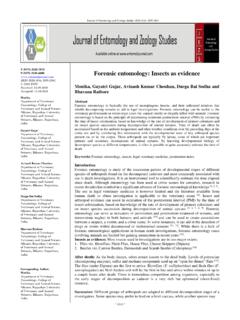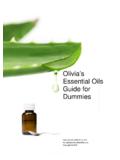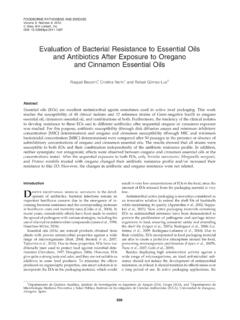Transcription of Insecticidal effects of essential oils against woolly
1 ~ 211 ~ Journal of Entomology and Zoology Studies 2015; 3 (3): 265-271 E-ISSN: 2320-7078 P-ISSN: 2349-6800 JEZS 2015; 3 (3): 265-271 2015 JEZS Received: 16-04-2015 Accepted: 19-05-2015 Aurash R. Yazdgerdian Faculty of Land and Food Systems, University of British Columbia, Vancouver, BC, Canada V6T 1Z4 Yasmin Akhtar Faculty of Land and Food Systems, University of British Columbia, Vancouver, BC, Canada V6T 1Z4 Murray B. Isman Faculty of Land and Food Systems, University of British Columbia, Vancouver, BC, Canada V6T 1Z4 Correspondence: Yasmin Akhtar Faculty of Land and Food Systems, University of British Columbia, Vancouver, BC, Canada V6T 1Z4 Insecticidal effects of essential oils against woolly beech aphid, Phyllaphis fagi (Hemiptera: Aphididae) and rice weevil, Sitophilus oryzae (Coleoptera: Curculionidae) Aurash R.
2 Yazdgerdian, Yasmin Akhtar, Murray B. Isman Abstract Eleven essential oils (Citrus aurantium, Citrus sinensis, Citrus limon, Eugenia uniflora, Ocimum gratissimum, Rosmarinus officinalis, Gaultheria procumbens, Thuja plicata, Pseudotsuga menziesii, Abies grandis, Bursera graveolens) were tested against Phyllaphis fagi, as contact and residual toxins. Abies grandis (LC50= ) was significantly the most active contact toxin followed by the positive control, R. officinalis (LC50= ), P. menziesii (LC50 = ), B. graveolens (LC50= ), and T. plicata (LC50= ). Five of these essential oils were also tested against Sitophilus oryzae for fumigation effects .
3 Based on the LC50 values of the oils , G. procumbens was the most active fumigant (LC50= l/l air). Thuja plicata and B. graveolens oils were equitoxic. Rosmarinus officinalis and A. grandis were the least toxic (LC50= and l/l air respectively). In a grain-treated bioassay against S. oryzae, G. procumbens was the most active (LC50= l-g-1) followed by R. officinalis. Thuja plicata and B. graveolens were equitoxic. Abies grandis was the least toxic. These oils exhibit different modes of action and have potential to be used as commercial insecticides against P. fagi and S. oryzae. Keywords: Phyllaphis fagi, S. oryzae, contact toxicity, residual toxicity, essential oils , grain protectant 1.
4 Introduction The woolly beech aphid, Phyllaphis fagi, and rice weevil, Sitophilus oryzae, are serious pests worldwide. P. fagi is a specialist on the European beech tree, Fagus sylvatica [1] and is responsible for reducing the aesthetics of F. sylvatica in nurseries, causing economic losses to the nursery industry. It also attracts other insects to the site and may change the local community structure of the canopy shed [2]. This is especially critical in regenerating beech forests since younger beech trees are more prone to aphid infestation and damage [2]. Heavy infestations of P. fagi may also change the emission levels of biogenic volatile organic compounds (BVOCs) in F.
5 Sylvatica [1]. Infestation of F. sylvatica by P. fagi caused an increase in the release rate of terpenoids from 57 g m-2 h-1 to 127 g m-2 h-1, possibly affecting global atmospheric levels [1]. Severe aphid infestation can reduce photosynthetic rates of host plants like F. sylvatica and thereby increases the overall carbon content in the atmosphere, having severe implications on climate change. Sitophilus species cause considerable economic losses to stored wheat grain. Heavy infestation of these pests due to the lack of proper food hygiene and storage may cause weight losses of as much as 30 40% [3]. Direct feeding on the grain kernels may cause unfavorable effects on food quality, safety, and preservation [4].
6 Control of these insects relies heavily on the use of synthetic insecticides including organochlorines (lindane), organophosphates (malathion), carbamates (carbaryl), pyrethroids (deltamethrin) and fumigants including methyl bromide, phosphine, and sulfuryl fluoride. However, the indiscriminate application of synthetic products has led to various problems including toxic residual effects , environmental pollution, and development of resistance in insects [5]. Therefore, there is an urgent need to develop safe, convenient and low-cost alternatives. Considerable efforts have been focused on the use of plant-derived materials including essential oils as bioinsecticides.
7 essential oils have demonstrated toxic effects against stored-product insects [6] as well as agricultural pests [7, 8]. They may act as fumigants [6, 9, 10], contact insecticides [9, 11], antifeedants [8, 12] or repellents [11, 13]. ~ 212 ~ Journal of Entomology and Zoology Studies essential oils also have a long history in medical and dietary uses [14] and in the USA are Generally Recognized as Safe [15]. Due to their low mammalian toxicity [16] they could be used as alternative sources for controlling a number of insect pests including stored-product insects [4]. Plant essential oils and their constituents have been shown to possess potential for development as new fumigants and they may have advantages over conventional fumigants in terms of low mammalian toxicity and low environmental impact.
8 The objective of this study was to screen essential oils as effective contact or residual toxicants against the woolly beech aphid, P. fagi, and as fumigants against the rice weevil, S. oryzae. Species were chosen because of their world-wide pest status as well as their availability. Selection of essential oils for the experiment was based on prior knowledge of their Insecticidal activities against related insect species. Families Lamiaceae (including R. officinalis and O. gratissimum), Rutaceae (including C. aurantium L., C. sinensis var. pera Osbeck, and C. limon), Myrtaceae (including E. uniflora), and Cupressaceae (including T.)
9 Plicata) are specifically known for their Insecticidal effects against hemipterans (including the aphids) and coleopterans (including the weevils) [16]. None of the oils used in our study have been tested against P. fagi and only some against S. oryzae for contact, residual, or fumigant effects , to the best of our knowledge. 2. Materials and Methods Period of Study This study was carried out during April-December, 2012. Test substances essential oils used in the study (Table 1) were obtained from different sources. Rosemary, wintergreen and conifer oils were provided by Ecosafe Natural Products Inc. (Canada). Citrus and Eugena oils were provided by Dr.
10 Claudio A. G. da Camara (Univ. Federal Rural de Pernambuco, Brazil). Test Insects woolly Beech aphid Aphids were collected from European beech trees, Fagus sylvatica, on the University of British Columbia campus during the months of May and June of 2012 under typical Vancouver spring weather. Early nymphal stages were distinguished from the mature stages by size and density of a wax-cover, particularly on their abdomens. Early staged nymphs and winged adults were not chosen in order to reduce variability. Approximately 100 third-fourth instar aphids were stored in a plastic container (diameter: 4cm; height: 3cm) and were immediately used in the experiments.













